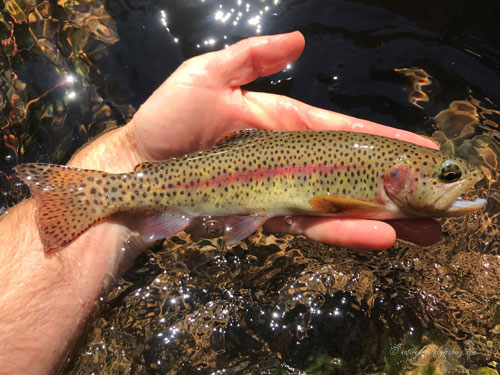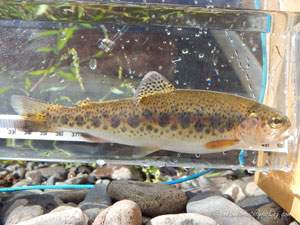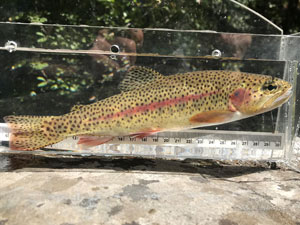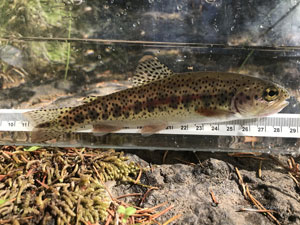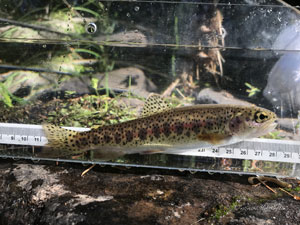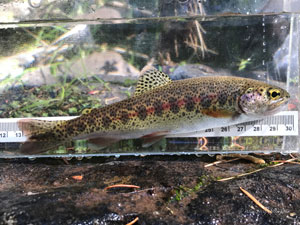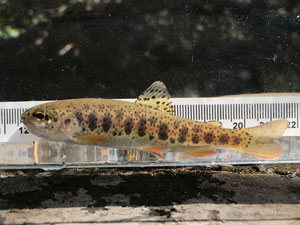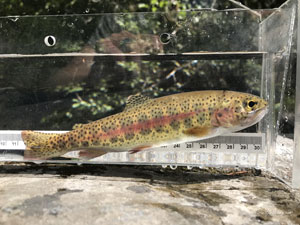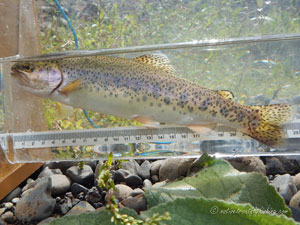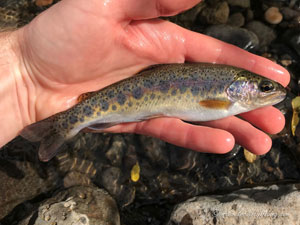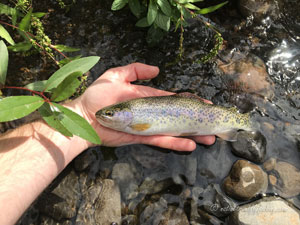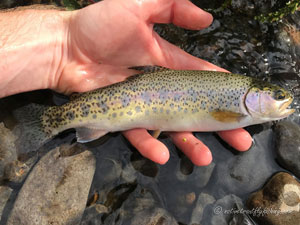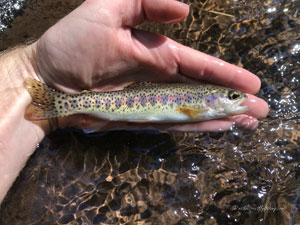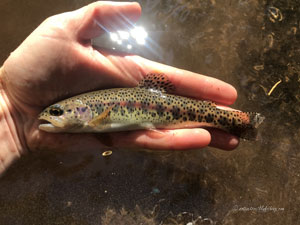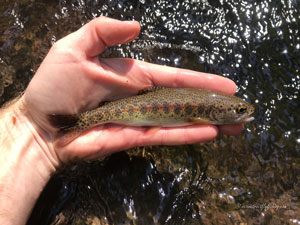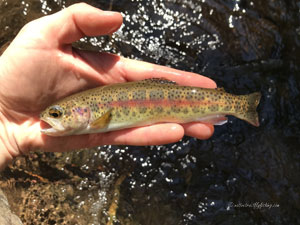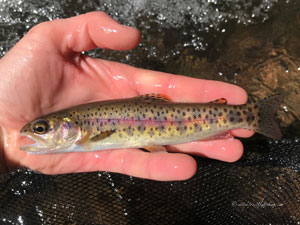White River Redband
Oncorhynchus mykiss ssp.
A White River Redband from a small Oregon stream
Introduction
The White River Redband Trout is unique lineage of Redband Trout native to the White River, a tributary to the Deschutes River in Oregon, USA upstream of a barrier waterfall. This fish has not been formally described as a subspecies, but genetic analysis show that it is an ancient lineage more akin to Fort Rock Redband than it is to the Columbia Basin Redband, located downstream in the Deschutes River (Currens et al. 1990, Currens et al. 2009).
Life History Information
White River Redband, inhabit the White River and its tributaries upstream of White River Falls and exhibit both fluvial and stream resident life histories. The White River is a glacial stream draining from Mt. Hood and the habitat utilized by these fish ranges from high mountain to sage brush desert, with small stream tributaries making up 75% of the habitat (Schroeder and Hall 2007). The highest Rredband densities in the basin are typically in lower elevation stream reaches as these tend to be more productive than they higher elevation areas. Most White River Redbands are between 1-3 years old, with some individuals up to 5 years old. Little is known about the diet of these fish, but they are likely primarily drift feeders, with older larger fish likely preying on other fish once they reach a large enough size. Growth is higher in the main stem White River than its tributaries with fish putting on 4.7” (11.9 cm) in their first year in the main stem versus 3.2” (8.1 cm) in tributaries (Schroeder and Hall 2007). These Redbands spawn in the spring, typically at age 3-4 and often put on addition growth after reaching maturity. No formal studies have been conducted on the early life history of White River Redbands, so little is known about emergence time or habitat utilization, but it is assumed to be similar to other Redband populations.
Status
The White River Redband is still found throughout its native range with good connectivity between the habitat. While logging, agriculture and other human related activities have had an impact on it, a potential looming threat is an eruption of Mt. Hood from which the White River has its source. However, lahars associated with Mt. Hood have occurred in the past couple hundred years and these trout have been successful at recolonizing the basin. As with other native trout, the introduction of non-native species poses the greatest threat to White River Redbands. Non-native Rainbow Trout were introduced to the basin and appear to have hybridized with Redbands in the lower watershed (Currens et al. 1990), but it is unclear how significant this influence is on the native Redband Trout. Brook trout are currently found in several tributaries to the White River and appear to have displaced the Redbands in the upper reaches of these streams. The streams where Brook Trout are dominant tend to have low temperatures and significant slow pool habitat favored by Brook Trout (Schroeder and Hall 2007). However, studies have indicated that Rainbow and Redband Trout tend to be the dominant competitor with Brook Trout (Fausch 1988) and it is unlikely that Brook Trout will expand their range significantly beyond their currently occupied habitat. While no formal status reviews have been conducted, it is likely that the White River Redband currently has a low threat of extinction.
Description
The White River Redband is similar in appearance to other Rainbow and Redband Trout. These trout have a distinctive rose-purple to red band along their lateral line, with the same coloration on their gill plates. They are profusely spotted with small irregular shaped black spots above and below the lateral line and have 9-12 purplish parr marks that are often retained to maturity in stream resident populations. Their sides have a yellow to pale-golden tone, with a bronze coloration on the back. Scales on the White River Redband Trout are finer than those on Columbia River Redband found in the Deschutes River.
Stream Resident Form
Click on images to view a larger picture
Native Range
A map of the native range of the White River Redband Trout.
References
Currens, K.P., C.B. Schreck and H.W. Li. 1990. Allozyme and morphological divergences of rainbow trout (Oncorhynchus mykiss) above and below waterfalls in the Deschutes River, Oregon. Copeia 1990: 730-746.
Currens, K.P., C.B. Schreck and H.W. Li. 2009. Evolutionary ecology of redband trout. Transactions of the American Fisheries Society 138: 797–817.ODFW. 2005. Oregon native fish status report. Oregon Dept. of Fish and Wildlife, Salem, OR.
Fausch, K.D. 1988. Test of competition between native and introduced salmonid in streams: what have we learned? Canadian Journal of Fisheries and Aquatic Sciences 51: 2626-2637.
Schroeder, R.K. 2007. Redband trout in the Deschutes and White Rivers, Oregon. Pages 65–75 in R. K. Schroeder and J.D. Hall, editors. Redband trout: resilience and challenge in a changing landscape. Oregon Chapter, American Fisheries Society, Corvallis.
Contact
Feel free to contact me if you have any questions or comments
White River Redband Trout Links
Oregon Department of Fish and Wildlife - Redband Trout
Western Native Trout Initiative - Redband Trout
Native Trout Links
Truchas Mexicanas' - Native Trout of Mexico
Balkan Trout Restoration Group
Trout and Seasons of the Mountain Village - About Japanese Trout
Western Native Trout Challenge
California Heritage Trout Challenge
Fly Fishing Blogs
Dave B's Blog: Fly Fishing for Native Trout
The Search for Native Salmonids
Conservation Links
Western Native Trout Initiative
Fly Fishing Links
Fishing Art Links
Americanfishes.com - Joseph R. Tomelleri
Fish Eye Guy - Underwater Trout and Salmon Pictures
